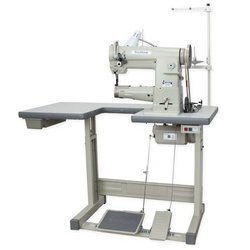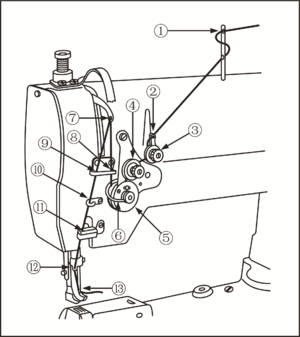Sewing Machine, Industrial Cylinder Arm Walking Foot, (Techsew TS-2750) ID:183
 Techsew TS-2750 | |
| Type | TechSew Cylinder Arm Walking Foot Sewing Machine |
| Make/Model | TS-2750 |
| Serial number | |
| Original owner | Protospace |
| Loan status | Owned |
| Arrival date | 2024-06-08 |
| Location | Sewing Room |
| Functional status | Operational |
| Usage permissions | Members only |
| Certification | Industrial Sewing Machine |
| Wiki-ID | 183 |
| Label | 1.0" 1.5" 2.0" |
Specs
From manufacturer website:
Designed for sewing leather products, nylon webbing, canvas, denim, synthetic materials and heavy fabrics
- Compound walking-foot feeding mechanism
- up to 1/2" thick leather
- Stitch Length: 1-9mm
- Reverse Feed
- 10" length, 3" diameter cylinder arm
- Needle
- System: 135X17 (DPX17)
- Size: 18 to 24
- Thread
- Top: Right Twist (Z)
- Bobbin: Right or Left (S or Z)
- Size: #45-#210
- Safety Clutch protects rotary hook
- Adjustable speed Servo motor 400-2000 SPM
Usage
Almost all machine functions are covered in the Techsew youtube documentation:
Playlist: https://www.youtube.com/watch?v=Qc7WBXREGpQ&list=PL4iVwH6cbP578HmtFcGT_cfE5wodn1RWf
Oiling: https://www.youtube.com/watch?v=IqG6p0OJkZo
Threading: https://www.youtube.com/watch?v=kGQq7n6modk
Startup: https://www.youtube.com/watch?v=doFv5mRpels
Note: The 2750 and 2750 pro are the same machine with extra features bolted on. We have the non-pro version. The instructions are mostly the same between the models. The non-pro does not have a needle positioner.
Always power off the unit before any mechanical adjustments, accessory changes, needle changes, or threading.
Caution: The foot pedal WILL STILL OPERATE THE MACHINE for a few revolutions if the controller has recently been powered off. The servo controller will retain a moderate capacitor charge after powering off. To drain this charge, firmly hold the hand-wheel while gently depressing the pedal - the motor will try to turn at low speed but will quickly run out of power. Once the capacitors are drained, the unit is safe to work on.
| Metric Needle Size | Needle size | Compatible Thread size |
| 100 | 16 | 30, 46, 69 |
| 105 | 17 | 30, 46, 69 |
| 110 | 18 | 46, 69 |
| 120 | 19 | 69, 92 |
| 125 | 20 | 69, 92 |
| 130 | 21 | 69, 92 |
| 140 | 22 | 92, 138 |
| 160 | 23 | 138 |
| 180 | 24 | 138, 207 |
Threading
Startup
- Assume someone changed the configuration since the last time you used the machine. Inspect everything.
- Power OFF the machine to inspect, oil, and thread:
- Ensure switched off, and capacitor drained per warning above
- Inspect all moving parts for correct installation, wear, and damage. (bent needle, etc)
- Lubricate all oil points (red paint marks) with sewing machine oil.
- Thread machine
- Install bobbin
- Bobbin carrier is held in with a spring latch, lift it with a fingernail or flat screwdriver, then remove the carrier+bobbin.
- Install new bobbin in carrier - Thread should be wound clockwise when viewed from the 'underside' of the carrier. (bobbin will rotate clockwise when thread is pulled out).
- Slide the thread under the bobbin carrier spring, and route upwards through the notch in the carrier.
- Install the bobbin carrier into the machine, and lower the spring latch.
- Run the threaded machine forward 1 revolution by hand to take up the bobbin thread.
- Profit.
Machine Operation
Operation tips:
NEVER run the machine backwards. Use the reverse lever to back up. If you've gone forward enough to puncture your material with the needle, it's too late to go back. Finish that stitch. If you run backwards, you WILL knot the upper thread around the bobbin carrier and it will need to be unblocked involving some machine surgery.
NEVER run the machine with the presser foot raised. Same thing - Raising the presser foot releases thread tension, and without tension the thread will get trapped under the bobbin carrier.
Use the right pedal to lift the presser foot and release tension to install/remove your work piece.
Use the left pedal to sew. Sewing speed is variable starting at a minimum 400spm. If the controller is set higher, full deflection of the pedal will result in full set speed. Minimum deflection will always start at 400spm speed for brushless servo motor torque/control reasons.
Hold tension on the loose thread ends towards the rear of the machine at the start of each first stitch.
Shutdown
- Always power down the machine when not actively using it. Make it a habit, even if just stepping out of the room.
- Remove your thread: Most excellent: cut your thread at the spool, leaving a remnant that can be tied to the next spool to speed threading.
- Clean all surfaces in and around the machine: Remove offcut threads, dust bunnies, debris, etc.
- Remove any accessories installed (binding edger, flat-top, etc)
- Cover the machine __todo: sew a cover, in the meantime, use any cloth.
Install accessories/feet
Follow the video guides. Return machine to factory default when you are done.
Virtually every screw on the machine is flat-head. With the correct size screwdriver, these can and should be significantly torqued.
USE THE CORRECT SIZE FLAT-HEAD SCREWDRIVER TO NOT MANGLE THE SCREWS.
Install/change needle
- Raise needle bar to highest position using the hand wheel.
- Hold existing needle to prevent it falling when loosened.
- Use a flat-head screwdriver to loose the needle set screw.
- Remove the old needle, and replace with new needle.
- The needle shaft is round - orientation matters!
- Long groove on the left, Scarf on the right
- Tighten needle set screw.
Bobbin Winder
- Operates on the main machine belt: the needle/feed will operate while winding the bobbin.
- Always remove the upper thread from the needle before operating the bobbin winder to prevent a blockage. Best practice is to unthread to before the take-up arm to prevent thrashing.
- Thread through the thread arm above, then winder tension guide hole (back right of table), tension disc, and forward to the bobbin.
- The bobbin winder will automatically disengage from the belt at about 80% full. Do not overfill the bobbin.
Troubleshooting
| Problem | Symptom | Cause | Solution |
|---|---|---|---|
| Thread Tension | Top thread showing on bottom | Improper tension / wrong needle | Increase top tension, reduce bottom tension
Use appropriate size needle for fabric/thread. |
| Bottom thread showing on top | Decrease top tension, increase bottom tension
Use appropriate size needle for fabric/thread. Too large needle will leave large holes that allow opposite thread to show. | ||
| Fabric puckering between stitches | Tension too high | Decrease both top and/or bottom tension | |
| Thread Blockage | Handwheel stuck/won't turn much | Bobbin mechanism jammed with thread | Thread blocked/tied around/under bobbin carrier. Requires bobbin carrier disassembly. See Video |
| Timing off | Skipped stitches | Crash/severe blockage, improper adjustment. | See Video. Hook timing will likely need to be reset after a crash or blockage. Remove bevel gear cover, Move needle to bottom dead center, loosen bevel gear set screws, adjust hook until timed to catch thread from needle at bottom dead center. Tighten set screws, and check back and forth for hook/needle collision. Reassemble/re-thread. |
| Safety Clutch | Motor/handwheel turns but no machine action | Crash/Severe blockage | Safety clutch popped - Depress shaft lock button and rotate handwheel forward until clutch re-engages. See Video. |
Documentation
PDF on google drive
